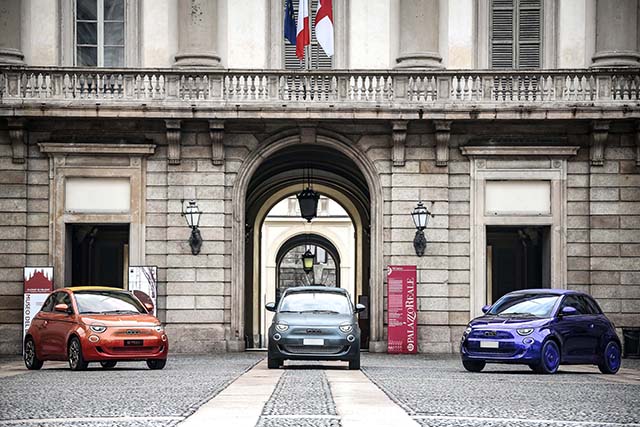Italy – a country revered for its piquant cuisine, dandy fashion designs, extravagant countryside and cities sublime and unique.
The Italians have the secret to success and it is to keep it simple yet bask in elegance. Their every essence is confirmation of this. Italian culture lives through various industries ranging from film and arts to culinary delights, fashion and in the motoring industry, they’ve proved that they can rumble with the best of them.
Italian car legends such as Maserati, Ferrari, Alfa Romeo and Lamborghini come to mind. How could they not? These brands produce some of the world’s most expensive and luxurious supercars.
Yet for someone whose personality doesn’t fit the mainstream definition of style, who has a palate for the quirky and unorthodoxically attractive – the Fiat 500 has cemented its place in pop culture history.
For decades it has imprinted its stance in the motoring industry by always keeping up with the times, motoring expectations and global developments. Much like the ‘Knight Rider’s’ Kitt, Bruce Wayne’s Batmobile, DeLorean, the Mystery Machine and Mr Bean’s citron-green 1977 British Leyland Mini, the Fiat 500 has earned its icon status.
Historical Icon
The 1957 bright yellow Fiat 500 is the trusty companion of one of Japanese manga’s most famous characters, Arsène Lupin III, the protagonist of ‘Lupin III’ – a series written and illustrated by Money Punch.
This car was originally produced from 1957 to 1975 as a rear-engined, four-seater city vehicle in two-door body designs. These original models are rounded bodies that look like specimens that should be sold in a toy factory, however, it is its size that makes this car desirable as a quick and easy tool to get from where you are, to where you’re going.
Initially in 1949, the brand released the front engine Fiat 500 economy car to nourish the wounds World War 2 left on the vehicle market. It was designed as a two-door coupe body with sun-roof, which was later complemented by an estate version.
Both these versions would only last about half a decade as they were discontinued and replaced by a lighter, rear-mounted engine fashioned on the styling of the Volkswagen Beetle. This era quite brimmed with this positioning of the engine – a practice which is not popular in today’s engineering and designing aspects of cars.
A popular vehicle in Europe for its size and practicality at the time, the Fiat 500 proved to be one of the initial purpose-designed city vehicles. The Fiat 500 Nuova was launched in 1957, measuring in at 2,97metres and powered by a 479cc two-cylinder, air-cooled engine.
Thirteen years ago, Fiat celebrated the 50th anniversary of the Nuova 500’s launch with a modern and up-to-date version inspired by its predecessor, only this time with a front-mounted engine and front-wheel drive. This 2007 model would be the basis for the new wave of Fiat 500s that are taking over the market today in immaculate fashion.
The world is forever changing and developing and populations are only growing. All these elements further lead to urbanisation when young people look for jobs or opportunities to attend university and as a result, major cities are congested as infrastructure struggles to keep up.
Often times public transport is not up to scratch to assist young and driven professionals who are always on the go. The answer to all your over-populated, intolerable city woes is naturally Fiat’s pocket-sized city conquerer.
Constantly aiming to keep up with technological advancements and environmental stipulations, Fiat seamlessly creates a car for the middle-and upper-middle-class who still feel the need to be chic and classy or sporty when needed.
500 Star and 500 Rockstar
Eleven years after its re-introduction to the industry, the Fiat 500 achieved its all-time best annual sales figures globally with 194 000 units hitting the registry. This smart car is also the Fiat Chrysler Automobiles Group’s best-selling model for two and is the current kingpin in the European city-car segment.
The Fiat 500 also gave birth to the 500 ménage comprising of the 500, 500X and 500L models which will soon reach a combined three million units sold in Europe.
“These are outstanding figures, for a model that has never gone out of fashion through its 12-year history, and in fact has kept on evolving, without ever losing its identity,” Luca Napolitano, head of EMEA Fiat and Abarth brands, explains.
“The next verse of the song is 500 Star and 500 Rockstar, extending and enriching the 500 to make it even more universal, even younger, and even more exciting.”
Fiat is introducing two new members to the entourage which unites the brand’s cultural essence, luxury and sporty sides. The refined Lounge trim is now raised to fresh heights by the new Star model, while the 500’s sportier character comes to the fore in the feisty 500 Sport and the new, even more dynamic Rockstar, much to the pleasure of a more youthful market.
In a bid to attract this crowd, Fiat has made the decision to make the Lounge and Sport variations more economically priced and by offering the Uconnect 7-inch HD Live touchscreen radio, Apple CarPlay, as well as ready and compatible with Android AutoTM as standard, making road trips and commutes pleasurable and unique experiences. Over its twelve-year lifetime, the Fiat 500 has offered more than 40 colours across the range, more than half of them completely new, making it the FCA Group’s most colourful car. Of special distinction will be the new ceramic-look mica colour with pink tints of the Star trim, alongside the new matte green paintwork that debuts on the 500 Rockstar.
These two new additions to the family are available in hatchback and cabriolet body styles each accentuated with its own 16-inch wheel designs. The 500 Star and Rockstar are powered by Fiat’s TwinAir petrol engine. This turbocharged two-cylinder 875cc produces an impressive 62,5kW at 5 500rpm and a variable torque of 145Nm at 1 900 rpm. The combination allows effortless urban driving and impressive fuel consumption, returning just 4 l/100km on the combined cycle.
Economically and
Environmentally Friendly
In addition to the Fiat 500 Star and Rockstar models the manufacturer last week also revealed the Fiat 500 Electric in Milan, Italy – FCA Group’s first fully electric car. In a bid to become a more green and environmentally-friendly brand, Fiat has teamed up with other like-minded Italian-made stakeholders, Giorgio Armani, Bvlgari and Kartell, thus three unique and exclusive one-offs of the all-new model came to fruition.
This strategy aimed at improving the planet’s condition also includes a charity auction where the proceeds from the sale of these three models – the 500 Giorgio Armani, the B.500 ‘Mai Troppo’ by Bvlgari and the 500 Kartell – will go to one of actor Leonardo DiCaprio’s environmental organisations. As it is electric, there are often issues of concern for customers with charging. The lithium-ion batteries with a capacity of 42kWh give the 500 Electric a range of up to 320km. The New 500 is equipped with an 85kW fast charger system to charge the battery quickly and it takes only five minutes to build up a sufficient energy reserve to travel 50 kilometres, more than is needed for average daily use. The fast charger can also charge the battery to 80% in 35 minutes. Similar to its second-generation sibling, the new Fiat 500 is built on the same design aspects with a refined, crispier and blended touch.
The dividing line of the first generation separated the bonnet from the circular headlights, while today that separation has been redesigned, dividing the modular elliptical headlight with an eyelash on the bonnet. The Fiat 500 is certainly a range that is enticing to watch and even more thrilling to drive. With its non-binary appeal it’s a suitable vehicle for a range of young, boho-chic people who love to live on the edge and stand out from the rest.
– With additional information from QuickPic.
Stay informed with The Namibian – your source for credible journalism. Get in-depth reporting and opinions for
only N$85 a month. Invest in journalism, invest in democracy –
Subscribe Now!






